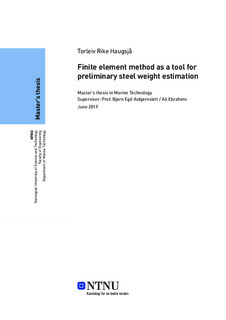Elementmetoden som et verktøy for estimering av stålvekt i konseptfasen
Master thesis
Permanent lenke
http://hdl.handle.net/11250/2626184Utgivelsesdato
2019Metadata
Vis full innførselSamlinger
- Institutt for marin teknikk [3432]
Sammendrag
Design prosessen for et cruiseskip starter med en konseptfase. På dette stadiet bestemmes en mengde forskjellige avgjørelser, inkludert hoveddimensjoner og et estimert budsjett. Stålvekt er en av de største utgiftspostene til den totale kostnaden. Av den grunn er det viktig å utnytte hoveddimensjonene slik at minst mulig stålvekt går med til å produsere det ønskede volumet. Å kunne estimere stålvekten basert på begrenset informasjon er også viktig for å forsikre seg om at budsjettet blir holdt.
Denne avhandlingen diskuterer bruken av elementmetoden som et verktøy for å minimere stålvekt og utvikle et parametrisk stålvektforhold for hoveddimensjonene til et cruiseskip.
Fremgangsmåten til løsningen kan ses som en stegvis prosess. Det første aspektet av problemet var å se på måter å minimere stålvekten. Dette ble gjort først for at resultatene skulle kunne brukes i andre fase av prosjektet. Den andre fasen var utviklingen av FEM-modellene, som brukes til å danne parametriske ligninger for de globale parameterne og vurdere deres innvirkning på stålvekten.
Tre forskjellige metoder for å minimere stålvekten ble forsøkt, hver metode angriper problemet på en egen måte. En particle swarm optimalisering (PSO) i kombinasjon med FEM, en topologi optimalisering av skroget og en parameter korrelasjonstest for forskjellige stiverprofiler ble testet. Resultatene varierte, men ga noen resultater som viste seg nyttig for å minimere stålvekt. Kort oppsummert; Flere stivere, minimere platetykkelsen, redusere flensbredde og L-profil for stivere ble funnet å ha en positiv innvirkning på stålvekten.
Kunnskapen fra vekt minimerings forsøkene, ble brukt på midtskips-skrogmodellene som var produsert ved hjelp av CAD og testet med FEM for å danne parametrisk relasjoner for hoveddimensjonene. Resultatene viste at å øke volumet av fartøyet ved å øke lengden var 2,54 ganger verre hva gjelder stålvekt, enn tilsvarende volumøkning gjort med økning av bredden. Den samme volum økningen gjort med økning av dypgang hadde vært 3,94 ganger bedre enn ved økning av lengden.
Metoden og funnene i denne oppgaven ga ikke et fullstendig stålvektestimat for et vilkårlig cruiseskip. En mer omfattende og detaljert modell var nødvendig for det. Forsøkene produserte vektreduserende tiltak og et forhold mellom hovedparameterne i form av stålvekt. Resultatene var gjeldende for et vilkårlig skrog og kan forhåpentligvis fungere som beslutningsstøtte for skipsdesignere som utvikler nye konsepter. The design process for a cruise vessel starts with a concept phase. At this stage a rangeof different decisions are made, included the main dimensions and an estimated total cost.Steel weight is one of the larger contributors to that estimated cost. Hence utilizing theglobal dimensions to obtain as much volume as possible, while minimizing the steel usageis key. Being able to predict the steel weight based on a limited set of information is alsoimportant to keep the project within budget.
This thesis discusses the use of finite element method (FEM) as a tool, to minimize steelweight, and develop a parametric steel weight relationship for the main dimensions of acruise vessels.
The approach towards the solution can be seen as a stepwise process. The first aspect of theproblem was to look into ways of minimizing the steel weight. This was done first in orderfor the results to be utilized in the second stage of the project. The second stage was thedevelopment of the FEM models needed to create the parametric equations for the globalparameters and their relation in regards to the steel weight.
Trying to minimize the steel weight was tried in three different ways, all attacking theproblem in a new way. A particle swarm optimization in combination with FEM, a topologyoptimization of the hull and a parameter correlation test for different stiffener profiles weretested. The result varied but yielded some results that proved useful for minimizing steelweight. In short; a higher number of stiffeners, minimize plate thickness, reduced flange width, and L-profile stiffeners were found to have a positive effect on the steel weight.
The weight minimizing knowledge was applied to the midships hull models, created usingCAD and tested with FEM to produce the parametric relation for the main dimensions.The results found that increasing the volume of the vessel by increasing the length was 2,54times worse in terms of added steel weight, compared to increasing the volume by increasingthe breadth and 3,94 times worse compared to increasing the depth.
The method and findings in this thesis did not provide a full steel weight estimate for anarbitrary cruise vessel, a more comprehensive and detailed model was needed for that. Theexperiments did produce weight reducing measures and a relationship between the mainparameters in terms of steel weight. The results were applicable to an arbitrary hull andcan hopefully serve as decision support for ship designer developing new concepts.
